« August 2006 | Main | October 2006 »
September 10, 2006
High Altitude Diving Certified!
I will not forget this day anytime soon. It was the day when I drove up to Lake Tahoe, dove Tahoe, and got certified as a PADI High Altitude Diver! I met Chuck Odell and his crew in Shingle Springs at 7:15AM and then we drove up into the Sierras on Highway 50 in convoy. The drive is very scenic and at times it's hard to keep your eyes on the road. There is just so much to see: forests and mountains and rocks and peaks and brooks and creeks in an ever-changing setting as you go higher and higher. 4000 feet, 5000 feet, 6000 feet... ears popping and you definitely can feel the altitude. The turbo motor in my PT Cruiser seemed totally unaffected; I was not. 7000 feet, and then Echo Summit at 7382 feet. As Chuck had requested, I mark the time when I pass the summit.
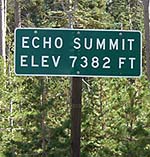 The air is much thinner up here. Which means the air pressure is lower. Since it took me all of an hour or so to drive up from Folsom which is essentially at sea level to Echo Summit, I am now the equivalent of a PADI P-diver. My body is dissipating nitrogen just as if I had just emerged from a dive. You add two PADI pressure groups per 1000 feet, so from zero to 8000 (you round up), it's 16 pressure groups once you reach the summit. Descending down to the Tahoe basin counts as surface interval time during which my body releases excess nitrogen. By the time I reach Meers Bay on the west side of Lake Tahoe and enter the water, an hour an a half will have passed. According to the PADI Recreational Dive Planner table, I will be a C-diver then.
The air is much thinner up here. Which means the air pressure is lower. Since it took me all of an hour or so to drive up from Folsom which is essentially at sea level to Echo Summit, I am now the equivalent of a PADI P-diver. My body is dissipating nitrogen just as if I had just emerged from a dive. You add two PADI pressure groups per 1000 feet, so from zero to 8000 (you round up), it's 16 pressure groups once you reach the summit. Descending down to the Tahoe basin counts as surface interval time during which my body releases excess nitrogen. By the time I reach Meers Bay on the west side of Lake Tahoe and enter the water, an hour an a half will have passed. According to the PADI Recreational Dive Planner table, I will be a C-diver then.
On the map it had looked like we'd just drive along the western side of Lake ahoe to arrive at the little state park that is Meers Bay. I wasn't prepared for some of the most scenic road I have ever been on, road that while more or less following the shore line, descended way up high for spectacular vistas. And it was a winding road to boot so I never quite knew what came first: my anticipation of the dives ahead, enjoying the terrific road, or marveling at the scenery around me. I did a bit of each.
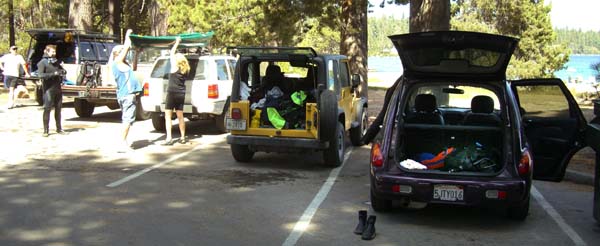
Meers Bay had a marina and a little resort but as far as state parks go, it is tiny. A machine takes your $5 bill and gives you a ticket, then it's on to the 20 parking spots or so. It's fairly brisk on this gorgeous September morning, though not nearly as chilly as on Echo Summit where the temperature had dropped to 43 degrees. It's perhaps 60 here, which feels cold to us spoiled Californians. We step out onto the picnick and beach area and marvel at how clean it is, and how beautiful. I go down to the shore and the water is just crystal-clear. None of the gunk and mud and garbage so prevalent in lakes and on beaches these days. Just sparkling, clean, wonderful water.
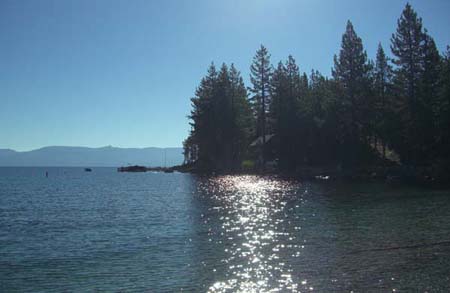
We grab a table and start shlepping our gear from the cars to the table. I am a worry-wart by nature and I am just SURE I forgot something crucial, despite having checked everything twice and despite having gone over the list with Carol. Miraculously it seems to be all there and accounted for, and so I carry my Stahlsack bag with all my gear to the table, bring over the big steel-95 tank, then change into my wetsuit. David, the student instructor Chuck is going to work with primarily, is checking out his gear, too, and wonders how he'll manage to get into his suit. Chuck makes it a bit easier by giving him a dive skin.
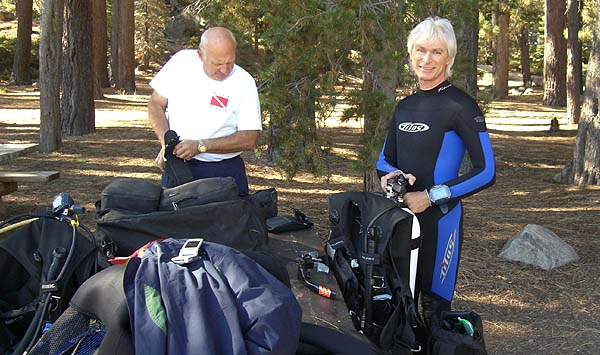
As we're almost all suited up Chuck declares that the water is a bit colder than expected and we should use gloves and hoods. I did bring my gloves, but I do not have a hood. Fortunately, Chuck has an extra and so this will also be the first time I'll be diving with a hood.
We go into the water, put on our BCs, struggle with getting the fins on (at least I struggle; I still don't have the hang of it), and then are ready to dive Lake Tahoe! Chuck explains the plan. Nevada requires a dive flag on the surface, so he'll have to bring that with us wherever we go. We'll first get used to the high altitude environment, then go down to perhaps 15 feet or so and he and David will do some of the mandatory PADI exercises. Then we'll go out farther until we reach the line where a 45 degree slope goes down many hundreds of feet. Lake Tahoe, you see, is almost 1700 feet deep.
So down we go. I am dazzled by the clarity of the water! Visibility seems at least 50 or 60 feet, and Chuck later confirms that. What a difference to Folsom Lake. The first thing we see is some small rocks that are the home of little Lobster-like crawfish. Chuck gently picks one up and shows him to us. The carwfish doesn't like it at all and shakes his claws. Chuck releases him and the little guy lunges right at me. I jump out of its way, which isn't nearly as easy underwater as above. Later I see much bigger ones of the same variety. Most seem quite combative, menacingly raising their claws when we take a closer look at them.
I then realize that all is not well with David. He can't descend! Not enough weight. So he and Chuck go back to the shore and add some more. Still not enough, and David ends up holding a large rock for most of the remainder of this dive. It looks rather funny. Eventually he and Chuck do their exercises and I am poking around, trying not to get too far away. The water is so wonderfully clear that I have none of the fear of getting lost. I am also quite pleased that Chuck neither gave me instructions nor appears to keep a close eye on me. I take that as an indication that he trusts me enough to let me do my thing. I am cautious, though, and stay close, just practicing floating around at neutral buoyancy.
I also monitor my dive computer and am pleased that I can read all the information on its screens, even without any sort of optical correction to accommodate my need for reading glasses on the surface.
Then Chuck takes us to the edge of the slope and down some. It's quite steep and so you go deep quickly. And the deeper you go, the less buoyant the suit becomes as the water pressure squeezes the air bubbles inside the suit, and so I have to compensate by adding air to my BC. I reach 40 feet and my sinuses hurt a bit. It's a weird feeling, and gets weirder as I look down the slope, knowing that it goes deeper than any human could dive on air. Then we go back up. Dive One done. It was terrific, it felt terrific, and I feel like screaming with joy as I surface. I think I actually did.
I used up more air during the 40 minute dive than I expected but everything else went well. The hood felt a bit weird at first, but there was no leakage. The gloves meant I had to move the dive computer farther up my arm, and there's no feeling in your fingers with gloves on, but it all worked just fine. And the gear kept me nice and warm during the entire 40 minute dive.
I had sort of expected a lecture from Chuck on what pressure group we were in now and so on, and a quiz on how long we should stay on the surface for however deep we were going to go on the enxt dive and so on. None of that, though, and I didn't even have time to change tanks before we were back in the water for Dive Two.
This one turns out to be my best dive yet! We again go down fairly close to the shore so David can do more of his mandatory exercises, and that includes the ever popular emergency diving ascent. While they do that I poke around and, since we are close to the slope and the water is clear enough for me to see both the diving line and Chuck on the surface, I decide to go down the slop a bit. 30 feet, 35 feet, 40 feet, 45 feet, 50 feet, 55 feet... The line now looks a little fainter, but I feel a great need to explore more. So I go down a few more feet, but then turn. I don't want for Chuck to think I am irresponsible, and I sure do not want to get lost having done this little excursion all by myself. So I add a bit of air to my BC and go back up. The computer shows that I reached 58 feet, by far a new record for me. And there's the dive line. In no-time I am back there. I feel elated!
But that is not all. Check points in a direction away from what I know is the shore and beckons us to follow him. I swim up to him, tap his arm and point at my computer gauge that shows tank pressure is down to less than 1000 psi. No problem, signals Chuck.
So we swim off and encounter perhaps the most amazing sight I have ever seen: a landscape full of giant rounded boulders, submerged at perhaps 35 feet ot water. It looks otherworldly and I feel a sense of wonder as I swim towards them and then around them. It's incredible. Chuck points to an area between two of the boulders and I see a school of silvery fish, many hundreds of them. I look at them, see them dart, in unison, this way and that, but also anxiously look at my pressure that has now reached just 500 psi.
On we swim, back into shallower water. It's just sand now with some old logs here and there, and an old rusted engine block. I tap it and rust flakes come off. We swim closer to the shore and then go up, with my tank down to 350 psi. I break the surface, high-five David, and again just want to scream with joy.
So those where my first high altitude dives. Turns out I did forget something -- my logbook! So Chuck cannot sign my dive logs and I have to fill them out later. Oh well. Other divers are milling around, and I see a couple with rebreathers. We talk a bit, then decide to head for Tahoe City to have lunch. That'll give us time to dissipate nitrogen and for me to get ready to ascend for Lake Tahoe (6200 feet) back up to Echo Summit. On the way back I stop at several lookouts and marvel at the scenery. Beautiful, so beautiful. I decide I want to come back diving here as soon as I can.
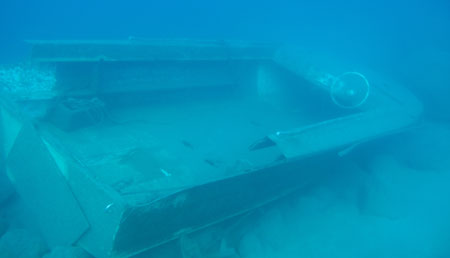
Posted by conradb212 at 10:59 PM
September 9, 2006
Diving Lake Tahoe!
Well, finally a trip to a real dive site! I am about to depart for Lake Tahoe where I'll be diving with my instructor, Chuck Odell, and one of his students. And I finally got my PADI C-Card! Now Tahoe is not just any dive site, but a high altitude dive site. We're talking 6,230 feet above sea level, and before you get there you have to cross over the Sierra Nevadas summit at 7,300 feet or so. Which, of course, means that this is high altitude diving.
The standard dive tables and rules apply to diving of up to 1,000 feet above sea level. Anything higher than that and different rules apply and different tables. That's because the air pressure is lower at altitude, which means several things. First, if you drive up to a high altitude dive site, you already carry residual nitrogen just from ascending to the higher altitude. In PADI speak, you advance two pressure groups for each 1,000 feet of altitude, and you, as always, round up to the next higher tound number. So the 7,200 foot summit is terated as 8,000 feet, which means you're a "P" diver once you get up there, and even your first dive will be treated as a repetitive dive.
I met with Chuck yesterday afternoon and we went over all the issues of high altitude diving. Not only do you need to treat the first dive as a repetitive dive, but you also need to compensate diving depth due to the lower air pressure. There are "altitude-adjusted" tables. On there you find that a 40 foot dive is to be treated like a 52 foot dive at 6,200 feet (rounded to 7,000), and a 50 foot dive like 65 feet.
It should be interesting! I loaded all my gear last night and hope I didn't forget anything.
Posted by conradb212 at 10:58 PM
September 5, 2006
"Crocodile Hunter" Steve Irwin killed in freak diving accident
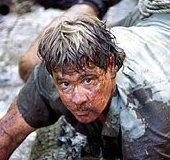 No sport is totally safe and for a while I occasionally listed diving accidents and fatalities in the news section of ScubaDiverInfo.com. I had set up Google alerts on "scuba," and, sadly, a good number of accident reports did come in. My guess is that's primarily the nature of news; generally it is only the bad news that is reported. I stopped reporting on bad news when there was criticism from a dive shop owner who has experienced tragedy in his life and who felt there was no need to highlight the bad.
No sport is totally safe and for a while I occasionally listed diving accidents and fatalities in the news section of ScubaDiverInfo.com. I had set up Google alerts on "scuba," and, sadly, a good number of accident reports did come in. My guess is that's primarily the nature of news; generally it is only the bad news that is reported. I stopped reporting on bad news when there was criticism from a dive shop owner who has experienced tragedy in his life and who felt there was no need to highlight the bad.
Statistically, scuba diving is quite safe. According to Diving Science by Michael B. Strauss, MD, and Igor V. Aksenov, MD, PhD, there is only one injury that requires medical attention per thousand scuba dives, and of those, only a tenth require recompression, or one in every 10,000 scuba dives. What does that mean? Carol has about 2,000 dives under her belt and she is a responsible, conscientious diver. According to the statistics, by now she might have had two situations that required medical attention, and from what she told me I think that is the case. Chuck, my PADI instructor, has 11,000 dives, and he claims he's never had any real problems, though I may quiz him on that a bit more.
Sadly, bad things do happen. I was really shaken when I learned that "Crocodile Hunter" Steve Irwin had died in a diving accident. Irwin, of course, was the boyish-looking, bubbly Australian nature documentary maker whose specialty was getting up close and personal with dangerous creatures. He did so in a unique, inimitable style that both highlighted and respected the animals. While he wrestled with crocodiles and had many up-close encounters with poisonous and otherwise dangerous creatures, he never failed to present them as beings with feelings, habits, lives. And he did so in an endearing, humorous style. Irwin's energy and enthusiasm was infectuous; he never did a boring show. As Americans we loved his Aussie accent, and his trademark expressions. "Crikey!" "She's a beaut!" "Oh, now he's cranky!" And so on.
I didn't even know Steve Irwin also did scuba diving, but that fits right in. On September 4, 2006, Irwin did underwater filming with his own production company off the Great Barrier Reef at Batt Reef at Low Isles. That is off the Port Douglas holiday resort north of Cairns, Queensland. I don't know how deep he was or what he was doing, but I have no doubt he got up close and personal with the creatures down there, as he always did with those gators and snakes. And this time a freak thing happened when the barb of a StingRay's tail punctured his chest. CNN reports that Irwin's cameraman was filming the whole scene, with Irwin over the top of the ray, the spike coming up, and Irwin pulling it out, but too late. [red CNN report on Steve Irwin's death]
Now the very name "StingRay" conjures up images of speed and a degree of reckless danger. General Motors named an early Corvette sports car the "StingRay." But StingRays are not dangerous, aggressive creatures. Like most sealife, they are passive and gentle and only seek to defend themselves. Many divers have swum with StingRays, and apparently there are very few reported serious accidents or deaths resulting from StingRay encounters.
But Steve Irwin's luck had run out. While StingRay barbs are poisonous, they are not usually deadly, but in this case, the barb punctured Irwin's artery or heart. Irwin was brought up by a rescue diver and emergency first aid was performed. It was too late. The Crocodile Hunter was dead. It's really quite shocking, and a reminder that accidents can happen to anyone. Steve Irwin was as familiar with large and potentially deadly animals as anyone, and he certainly knew what he was doing. And he was a qualifid PADI diver and most likely a good one. Yet, this happened. Very sad.
Posted by conradb212 at 10:57 PM
September 1, 2006
NAUI and PADI, and the next steps
Well, the world looks better today. My steel 95 tank is full, and I had a couple of great meetings that shed light on what happened with my dive shop alma mater. My C-Card should finally arrive next week or so, and I'll be helping out with web work in setting up a local diver's group.
The owner of my new dive shop also alerted me to a trip they'll be making in a couple of weeks. San Diego. I could be doing my advanced open water diving and Nitrox courses both at once, and he even hinted at wreck diving. The Yukon is in about 120 feet of water and supposedly a total blast. To be honest, I don't think I am anywhere near ready to wreck-dive at 120 feet. Heck, give me a nice, friendly 40 foot lake for half a dozen dives first. So why am I actually considering it? I'm really not, but the thought of a real dive trip in the very near future, and getting a couple more courses under my belt is nice.
Having completed the PADI Open Water Diver course, I am now working through the NAUI Scuba Diver course materials. The PADI and NAUI packages are quite similar. Both include a detailed, instruction book for self-study, both include video DVDs to complement the book, both include their respective dive tables, both include a student folder and medical questionnaire to be filled out, and both have other assorted odds and ends and stickers and offers and such. The NAUI package also contains two audio CDs.
Judging by what I have seen and heard, there is a philosophical difference between PADI's and NAUI's approaches to teaching scuba. Both teach the same basics and necessities, but PADI's is very consumer-oriented and friendly whereas NAUI goes into more technical explanations and details. Each instruction book is about 230 pages or so and covers all the basics, but the accompanying DVDs differ.
PADI's DVD repeats every word in the instruction book verbatum and simply illustrates what is in the book with actual footage. It tries to add a sense of humor that sometimes works and sometimes falls flat.
NAUI's video comes on two DVDs and also closely follows the instruction book, although not quite as verbatum as PADI's. One annoying quality here is that there are no breaks at all between topics in a chapter. The footage very quickly moves from one topic to the next without any discernible break. The screen shows a book and a write icon at times, indicating that you should consult the book or take notes.
The most confusing aspect I have encountered so far is the different dive tables PADI and NAUI use. They, of course, have the same purpose, that of letting you figure out how long you can stay at a certain depth, and how that will affect subsequent dives. The problem is that the tables and terminology are just different enough to thoroughly confuse you if you're used to the other agency's approach. It's a bit like driving a car with the steering wheel on the other side, or with the brake and clutch pedals switched. You know what they do and what you're supposed to do, but it sure doesn't come natural. No big deal, but it would make sense for all to use the same tables and terminology.
So far, the course materials look more similar than I expected based on Carol's very thorough and technical course outlines and PowerPoint presentations.
Posted by conradb212 at 10:56 PM








